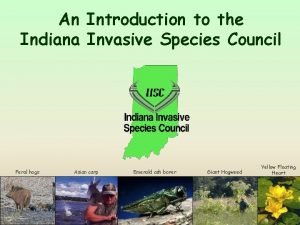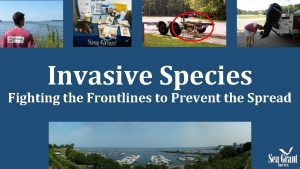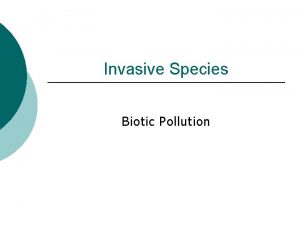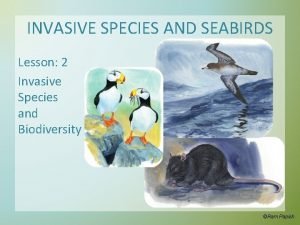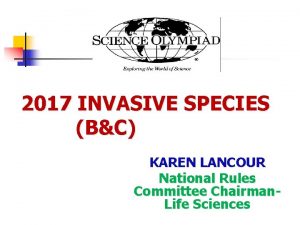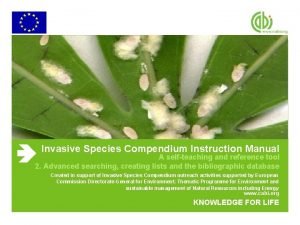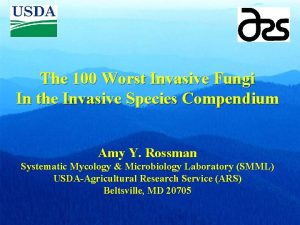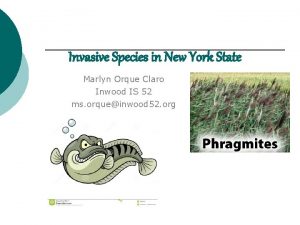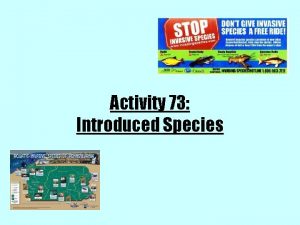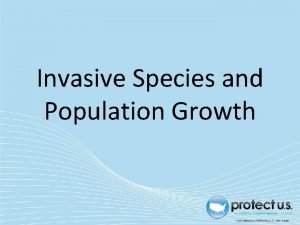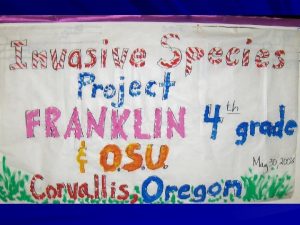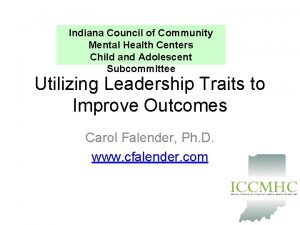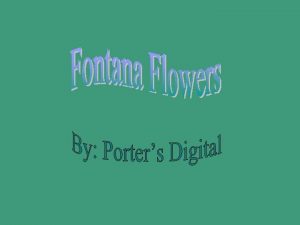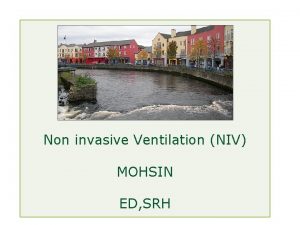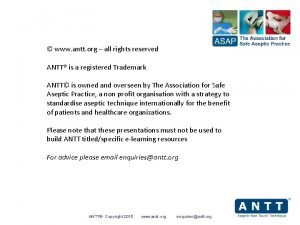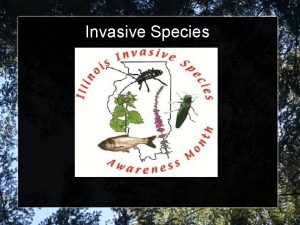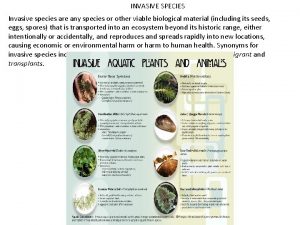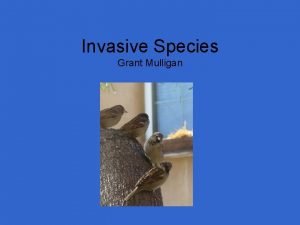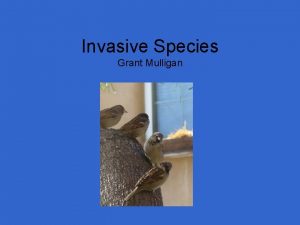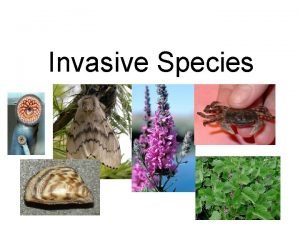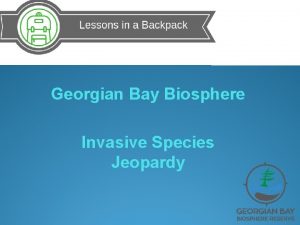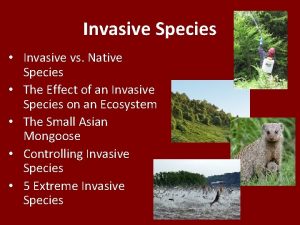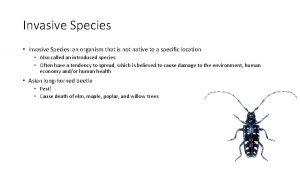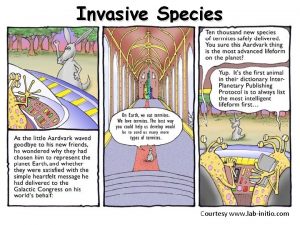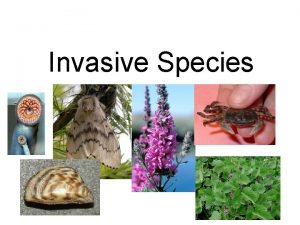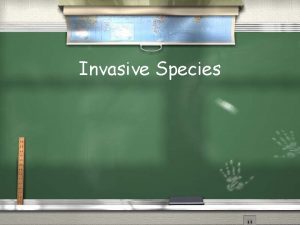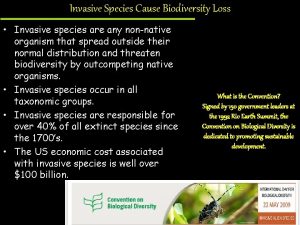An Introduction to the Indiana Invasive Species Council





















- Slides: 21

An Introduction to the Indiana Invasive Species Council Feral hogs Asian carp Emerald ash borer Giant Hogweed Yellow Floating Heart

Invasive Species An invasive species is defined as a species that is: • Non-native to the ecosystem under consideration and whose introduction causes or may cause economic or environmental harm or harm to human health. • Invasive species can be plants, animals, and other organisms including microbes. • Human actions are the primary means of invasive species introductions. Gypsy moth Hydrilla Japanese honeysuckle Johnson grass Brown marmorated stink bug

Invasive Species Affect People in Many Ways They can cause: Damage from EAB • Economic harm • Environmental harm • Harm to human health Kudzu West Nile Virus

The Economic and Environmental Costs of Invasive Species (IS) Are Remarkably High Worldwide, costs attributed to damage from IS are $1. 4 trillion per year, which represents nearly 6% of the world’s GNP.

• Invasive species cost the US over $138 billion per year. • Approximately 42% of threatened or endangered species are classified “at risk” due directly to nonnative invasive species. • In the US, approximately 9% of forest products – worth a total of $7 billion per year - are lost as a result of non-native plant pathogens. • To date, about 5, 000 types of alien plants are found in US ecosystems. • Alien weeds invade 1, 730, 000 acres of wildlife habitat per year in the US. • There are 180 non-indigenous aquatic species in the Great Lakes ecosystem. Of these, 15% cause serious harm. Pimental et al. 2003

Common Ways Invasive Species Are Moved • • • Ballast water Wooden packing material used in shipping Boating/recreation Live plants Live food industry Movement of infested firewood, logs, and nursery stock Releases from aquariums Escaped ornamental plants, nursery sales, and disposals Pathogens spread by non-natives to vulnerable natives Deliberate introductions Tourism Vehicular transportation

A Sampling of Invasive Species of Concern in Indiana

Invasive Plants Japanese stiltgrass (Microstegium vimineum) • First found in Crawford County in 1994. • Now found in 21 southern and central counties. • Creates “lawns” in forest understories that eliminate wildlife habitat and native plants. Tree of heaven (Ailanthus altissima) • Found in every county in Indiana. • Extremely common in urban areas where it can cause damage to sewers and structures. • Its invasiveness poses great environmental threat in cultivated fields and natural habitats.

Aquatic Invasive Species Sea Lamprey (Petromyzon marinus) • Native to Atlantic Ocean; came to Great Lakes in early 1900 s. • One adult sea lamprey can kill 40 pounds of fish. • Are a major factor in the decline in lake trout populations. Eurasian watermilfoil (Myriophyllum spicatum) • Widespread in Indiana. • Can completely displace native vegetation. • Has adverse affects on recreational activities such as boating and fishing. • Easily spreads and reproduces rapidly.

Insects and Plant Diseases Emerald Ash Borer (Agrilus planipennis) • 100% lethal to untreated ash trees. • Easily spread in firewood, logs, and nursery stock. • Found in over a third of Indiana counties. • Major financial concern for urban areas where ash is often overplanted. Thousand Cankers Disease of Black Walnut (Geosmithia sp. and Fusarium solani) • Fungal disease of black walnut trees, a highly valuable crop in Indiana. • Fungal pathogens are carried by the walnut twig beetle (Pityophthorous juglandis). • First found east of the Rockies in TN in 2010.

Terrestrial Invasive Vertebrates Feral hogs (Sus scrofa) • lllegally introduced by hunters. • Now found in 14 Indiana counties. • Can carry disease to domestic farm animals; cause damage to crops and forests. Mute swans (Cygnus olor) • Destroy up to 24 pounds of aquatic plants every day. • Known to attack other animals, including ducks, geese and other birds. • Will attack people.

Animal Diseases Chronic wasting disease (CWD) • Caused by prions. • Not yet been found in Indiana deer populations but present in whitetailed deer populations in Michigan and northern Illinois. • Because CWD is classified as a Transmissable Spongiform Encephalopathy (TSE), there is great concern by the public about consuming infected animals. West Nile Virus (WNV) • Potentially debilitating and fatal disease. • Affects birds, horses, and people. • Established in bird populations throughout Indiana. • Vectored by mosquitoes; birds serve as amplifying hosts. • Vaccination not currently available for humans.

Formation of the Council On August 13, 2009, Governor Mitch Daniels signed into law legislation creating the state Invasive Species Council. This action was based on the recommendation of a task force established by a joint House and Senate committee.

Duties of the Indiana Invasive Species Council (IISC) • Recommend project priorities, funding, and rules and laws • Identify lead agencies to develop useful inventories and databases. • Communicate with agencies and organizations outside of Indiana to enhance consistency and effectiveness. • Coordinate education and outreach activities. • Plan and conduct a public informational meeting every 2 years. • Help government agencies review and correct policies and procedures. • Help state agencies be accountable for their actions. • Receive and manage reports from all governmental agencies that act on the council’s recommendations. • Apply for and provide grants for education and management of invasive species.

Council Members • • • John Jachetta, Council Chairman Amy Cornell, Indiana State Department of Agriculture Bill Fielding, Indiana Department of Transportation Dr. Sandi Norman, Indiana State Board of Animal Health Eric Fischer, Indiana Department of Natural Resources’ Division of Fish and Wildlife Phil Marshall, Department of Natural Resources’ Division of Entomology and Plant Pathology Steve Yaninek, Purdue University, Council Secretariat Philip Gramelspacher, Indiana Forestry and Woodland Owners Association Rick Haggard, Indiana Nursery and Landscape Association Kristopher Krouse, Shirley Heinze Land Trust, representing land trusts, conservation and/or parks and recreation organizations John Williams, Director of Indianapolis Parks and Recreation John Jachetta, Dow Agro. Sciences

How the IISC Operates • Conducts quarterly public meetings during the first year. • Forms working groups to address specific issues. • Develops education and outreach initiatives. • Hosts a statewide conference every two years. • Presents issues and receive input from public.

Current Priorities of the IISC • Fill the open council position with a representative from industry. • Address funding issues. • Deliver public presentations about the roles and responsibilities of the Council. • Prepare the Council’s first report for the Natural Resource Study Committee. • Develop a long-term strategic plan for the Council • Review existing weed laws in Indiana. • Develop an education and outreach advisory committee.

Current IISC Working Groups and Advisory Committees • IISC Conference Working Group • Communications and Website Working Group • Data Collection and Management Working Group • Invasive Plant Advisory Committee • Aquatic Invasive Species Advisory Committee • Education and Outreach Advisory Committee

The Council’s most important function is to give citizens and industries a way to voice concerns and opinions about management of invasive species in Indiana while providing science-based, relevant information about current or emerging issues.

How to become involved in the IISC Visit the IISC Website for updates on invasive species issues in Indiana where you can: – Become a member of an IISC Work Group. – Find notices of upcoming public meetings. – Contact the Council with comments and suggestions. www. entm. purdue. edu/iisc/

Thank you for your interest in the IIS
 Indiana invasive species council
Indiana invasive species council Exotic species definition
Exotic species definition Invasive species characteristics
Invasive species characteristics Invasive species characteristics
Invasive species characteristics Invasive species characteristics
Invasive species characteristics Invasive species characteristics
Invasive species characteristics Invasive species compendium
Invasive species compendium 100 worst invasive species
100 worst invasive species Invasive species investigator worksheet
Invasive species investigator worksheet Invasive species investigator worksheet
Invasive species investigator worksheet Exponential growth of invasive species
Exponential growth of invasive species Are invasive species always bad
Are invasive species always bad Invasive species act ontario
Invasive species act ontario Indiana council of community mental health centers
Indiana council of community mental health centers Can plants be keystone species
Can plants be keystone species Invasive ductal carcinoma with medullary features
Invasive ductal carcinoma with medullary features Aspergilloma treatment duration
Aspergilloma treatment duration Non invasive halo brace
Non invasive halo brace Sesleria autumnalis spacing
Sesleria autumnalis spacing Non invasive ventilation
Non invasive ventilation Non invasive ventilation
Non invasive ventilation Valid safeguards in antt
Valid safeguards in antt
